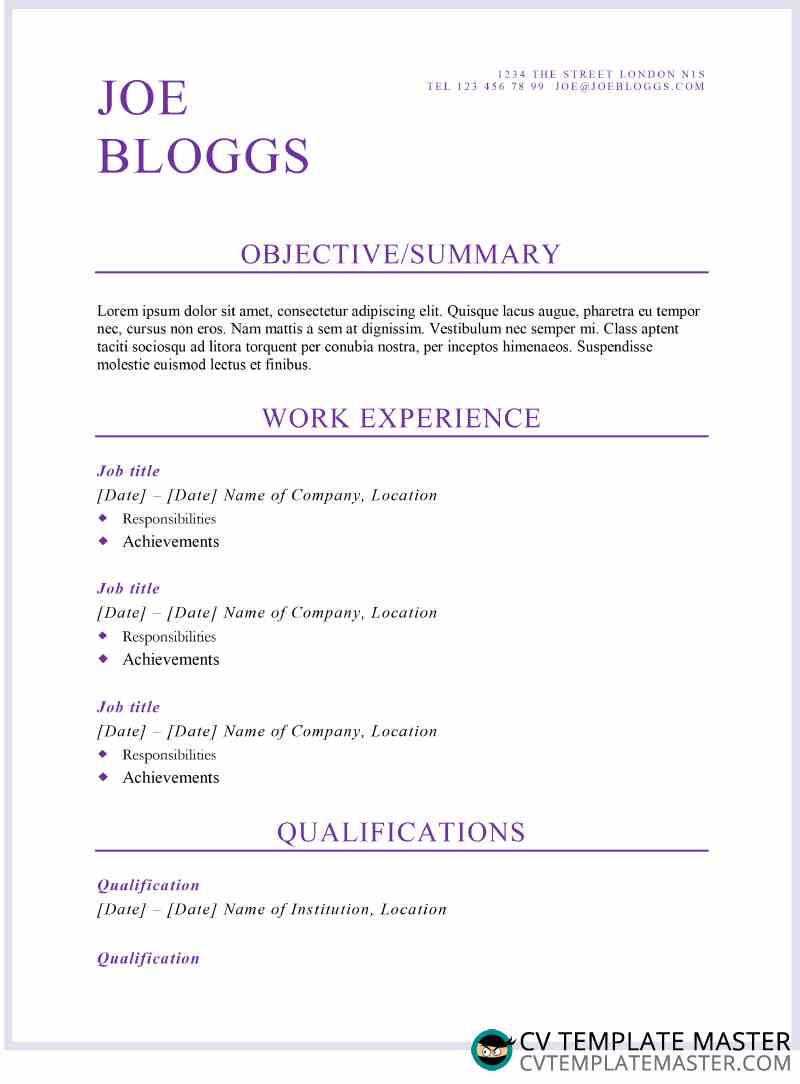Template details:

How to get the best from your purple flair CV or resume template
There is no one ideal way to create and present a curriculum vitae but these universal tips always apply:
1. Your CV is targeted to the specific role or career area for which you are applying and showcases the most significant skills you have to offer.
2. It is carefully and clearly laid out, logically ordered, easy to read and not crowded.
3. It is enlightening but succinct.
4. It is free from grammar, spelling or punctuation mistakes. If you mention attention to detail as a skill, make sure your spelling and grammar is excellent.
In addition to these ‘musts’, these are our top tips for customising this template:
1. Keep adjusting
If your CV is written backwards on fluorescent green paper and it lands you regular interviews, why think about changing it? At the end of the day if it is producing results, don’t be too eager to meddle with what works. By contrast, if it’s not getting you results, ask people you know to look it over and suggest changes. Having said this, if you make use of the template above as your starting point, you are unlikely to go far wrong.
2. Incorporate keywords
If you’ve uploaded your curriculum vitae to a job web site so recruiters can find you, keywords are especially significant. Job titles together with job keywords can help the search engines lift your CV to the top. To get inspiration for keywords, carry out a search on the web and see what words are often used when you put in your job title.
3. Keep it real!
Typically a curriculum vitae will be no longer than two pages – and by that we mean a couple of pages of A4 sheets of paper. Employers devote, on average, only 8 seconds browsing through a particular CV, and a guaranteed way of landing yourself on the no pile is to send them your entire life history. Always keep it punchy, relevant, and save the detail for your interview.
4. Jazz it up
Image is everything nowadays, and that also goes for your curriculum vitae. Devote some time to improving how the curriculum vitae looks, in addition to the content. Make use of bullet points to keep things well organised, and keep sentences punchy. Use the graphic design technique of allowing plenty of white space surrounding your text and around sections to make the CV easy to read.
5. Tailor it
It’s a pretty common trick. Sending an identical curriculum vitae to lots of employers to save time. Blanket messages bring small results so don’t fall into this trap – take the time to change your CV for each and every job that you send an application for. Research the corporation and use the job posting to work out precisely just what skills you should point out to them. They will welcome the patent effort.
6. Sell the details
Backing up your successes with numbers makes selling yourself much simpler. When writing your work history, don’t just mention that you boosted sales – tell them you boosted sales by 60 percent over a seven month period. Be specific.
7. Include an objective
Never just believe an employer will see how your experience relates to their position. Instead, make use of a short personal statement to make clear why you’re the ideal person for the position. This should be indicated in your cover letter as well.
8. Don’t lie
Outright lies on your CV can get you in a stack of trouble when it comes to employers verifying your background and references. The very last thing you need is to begin your new job and then lose your new role for lying. Also, you may get caught out during the interview when you suddenly can’t answer questions on what you claim to know. It’s never worth the hassle – don’t do it!
9. Don’t leave gaps without an explanation
Leaving noticeable gaps on your curriculum vitae immediately makes employers suspicious – and they will not give you the benefit of the doubt. If you have been out of employment it can be a worry but just turn it into something positive. Did you study for a qualification, do some volunteering or develop soft skills for example communication or teamwork? If that’s the case, make it very clear. Don’t suppose you will get the opportunity to explain at the interview – as the gaps may possibly put them off giving you a chance.
10. Correct your errors
Recruiters do scour for blunders on curriculum vitae and if they should spot them, it makes you appear sloppy. With many employers experiencing enormous volumes of applicants these days, providing them the excuse to dismiss your application on account of avoidable grammar and spelling errors is not going to assist you to secure an interview. Even if you think your spelling and grammar is awesome, use a spellchecker and ask another person to double-check what you’ve prepared – the ‘sanity check’.
11. Keep current
You should always keep your CV up-to-the-minute whether you are looking for a new role or not. Every time something significant happens in your career, record it so you don’t later forget something that might be relevant.